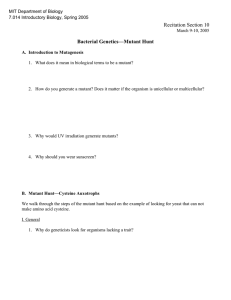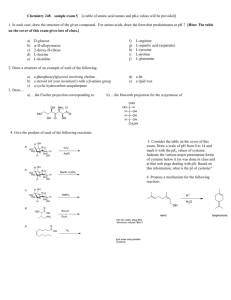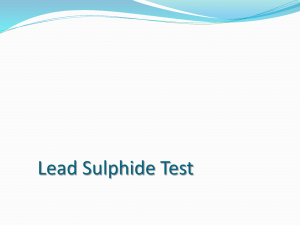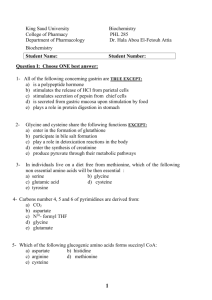Recitation Section 10 Answer Key Bacterial Genetics—Mutant Hunt
advertisement
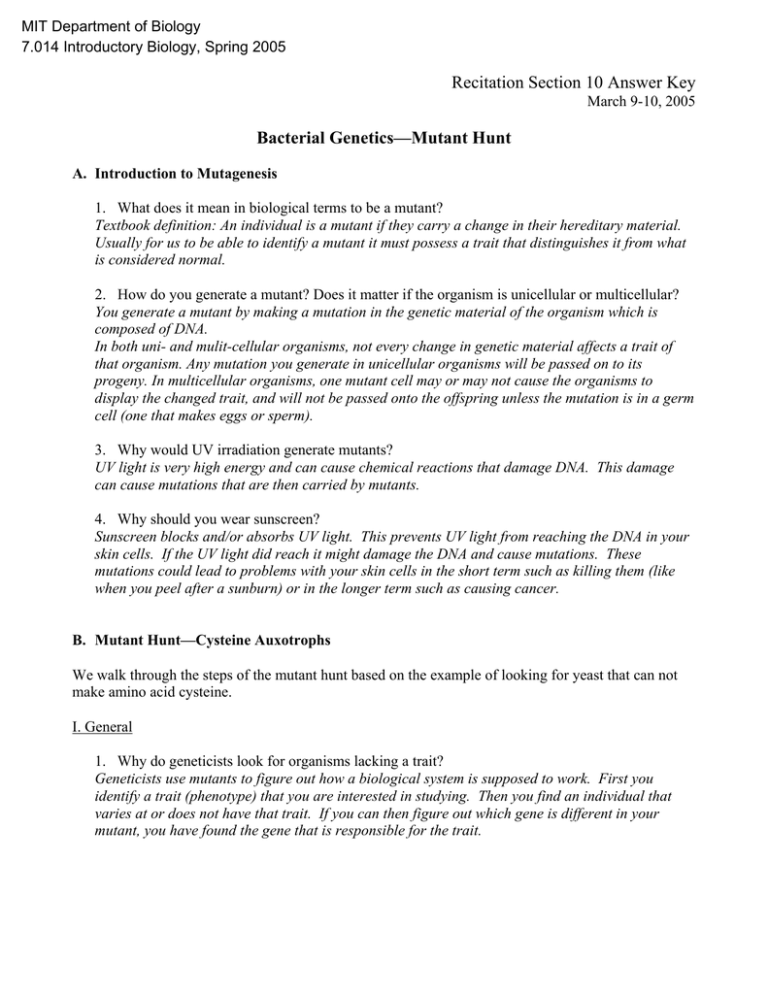
MIT Department of Biology 7.014 Introductory Biology, Spring 2005 Recitation Section 10 Answer Key March 9-10, 2005 Bacterial Genetics—Mutant Hunt A. Introduction to Mutagenesis 1. What does it mean in biological terms to be a mutant? Textbook definition: An individual is a mutant if they carry a change in their hereditary material. Usually for us to be able to identify a mutant it must possess a trait that distinguishes it from what is considered normal. 2. How do you generate a mutant? Does it matter if the organism is unicellular or multicellular? You generate a mutant by making a mutation in the genetic material of the organism which is composed of DNA. In both uni- and mulit-cellular organisms, not every change in genetic material affects a trait of that organism. Any mutation you generate in unicellular organisms will be passed on to its progeny. In multicellular organisms, one mutant cell may or may not cause the organisms to display the changed trait, and will not be passed onto the offspring unless the mutation is in a germ cell (one that makes eggs or sperm). 3. Why would UV irradiation generate mutants? UV light is very high energy and can cause chemical reactions that damage DNA. This damage can cause mutations that are then carried by mutants. 4. Why should you wear sunscreen? Sunscreen blocks and/or absorbs UV light. This prevents UV light from reaching the DNA in your skin cells. If the UV light did reach it might damage the DNA and cause mutations. These mutations could lead to problems with your skin cells in the short term such as killing them (like when you peel after a sunburn) or in the longer term such as causing cancer. B. Mutant Hunt—Cysteine Auxotrophs We walk through the steps of the mutant hunt based on the example of looking for yeast that can not make amino acid cysteine. I. General 1. Why do geneticists look for organisms lacking a trait? Geneticists use mutants to figure out how a biological system is supposed to work. First you identify a trait (phenotype) that you are interested in studying. Then you find an individual that varies at or does not have that trait. If you can then figure out which gene is different in your mutant, you have found the gene that is responsible for the trait. 2. How are genes responsible for traits? Genes are made up of DNA. DNA encodes the information of what the sequence of a protein is, when and how much of it should be made. This protein then performs the function that produces the phenotype. 3. Why would we be interested in cysteine biosynthesis? There are two main reasons: 1. Purely intellectual curiosity – how does a cell make cysteine? 2. The inability to synthesize cysteine is the cause of the human disease homocystinuria. Individuals with this autosomal recessive disorder suffer from a variety of symptoms including ocular, skeletal, neurological and cardiac defects. Maybe we can use yeast to find genes involved in the pathway and develop diagnostics or therapies using that information. 4. Why are we studying this process in yeast? Yeast is a eukaryotic organism like humans, but it is much simpler and easier to do experiments in for a few reasons: 1. You can grow many genetically identical individuals (clonal population - colony). 2. You can grow hundreds of different colonies on one 10cm wide Petri dish. 3. Yeast can grow as a haploid organism so you only need to make a mutation in one gene to see the phenotype even if the phenotype is recessive. 4. You can mutagenize, poison etc yeast without having much of an ethical conflict (and you don’t need approval from a review board). II. Technical issues 5. How do we make yeast mutants? We calculate the appropriate dose of UV radiation, the appropriate dilution of the cells, and the appropriate number of cells to plate on one 10 cm plate. We then place a plate with cells in liquid medium under the UV lamp, and turn the lamp on for the appropriate amount of time. After irradiation is complete, we dilute the cells to appropriate concentration, and plate on a number of Petri plates with appropriate media. 6. Will all the mutants we make be mutant in cysteine biosynthesis? No, we have no control over where in the organism’s DNA the mutation will take place. That is why we make a lot of mutants, and then screen or select them to identify the mutants we care about. 7. What is in complete medium? Sugar, salt, nitrogen source, amino acids 8. What is in minimal medium? Sugar, salt, nitrogen source, but not amino acids III. Planning the experiment 9. If you wanted to make media on which to grow a strain that was unable to synthesize cysteine, what would you need to put in it? Sugar, salt, nitrogen source, and cysteine 10. What medium could we use to screen for cysteine auxotrophs? Sugar, salt, nitrogen source, all amino acids except cyteine 11. What is a selective condition? Condition under which only some organisms will grow. These organisms have a particular phenotype that is being selected for or against. 12. Why don’t we plate the mutagenized yeast directly on selective conditions? Because our conditions select AGAINST the mutants we are looking for. Also, the mutation changes the future production of proteins involved in the cysteine biosynthetic pathway. The proteins are not effected by the UV radiation, so you have to wait until they are degraded (proteolysis) or diluted (cell division) before the phenotype is observable. 13. How should we find the rare mutant yeast that cannot synthesize cysteine within the large collection of yeast colonies we have on the plates? Transfer some of each yeast colony onto media that lacks cysteine and see which can no longer grow. The easiest way to do this is by replica plating. IV. Identifying mutants 14. When you “screen” the plates, how do you identify the mutants? The cysteine auxotrophs are ones that grow on the complete media (CM) plate but not the cysteine dropout (CD) or minimal media (MM) plates. 15. If we find some colonies that grow on CM but not MM, can we determine which amino acid they are unable to synthesize? Can’t tell immediately which amino acid they are unable to make but we know that it is not cysteine. 16. How might we figure this out? We could plate the strain on a variety of mediums, each lacking only one amino acid. This would let us determine which amino acid was required for growth. Alternatively, we could plate the strain on minimal media with one amino acid added on each plate and determine which one was required. Either strategy could be made more efficient by pooling (examining the requirement for 5 or so amino acids at a time).
